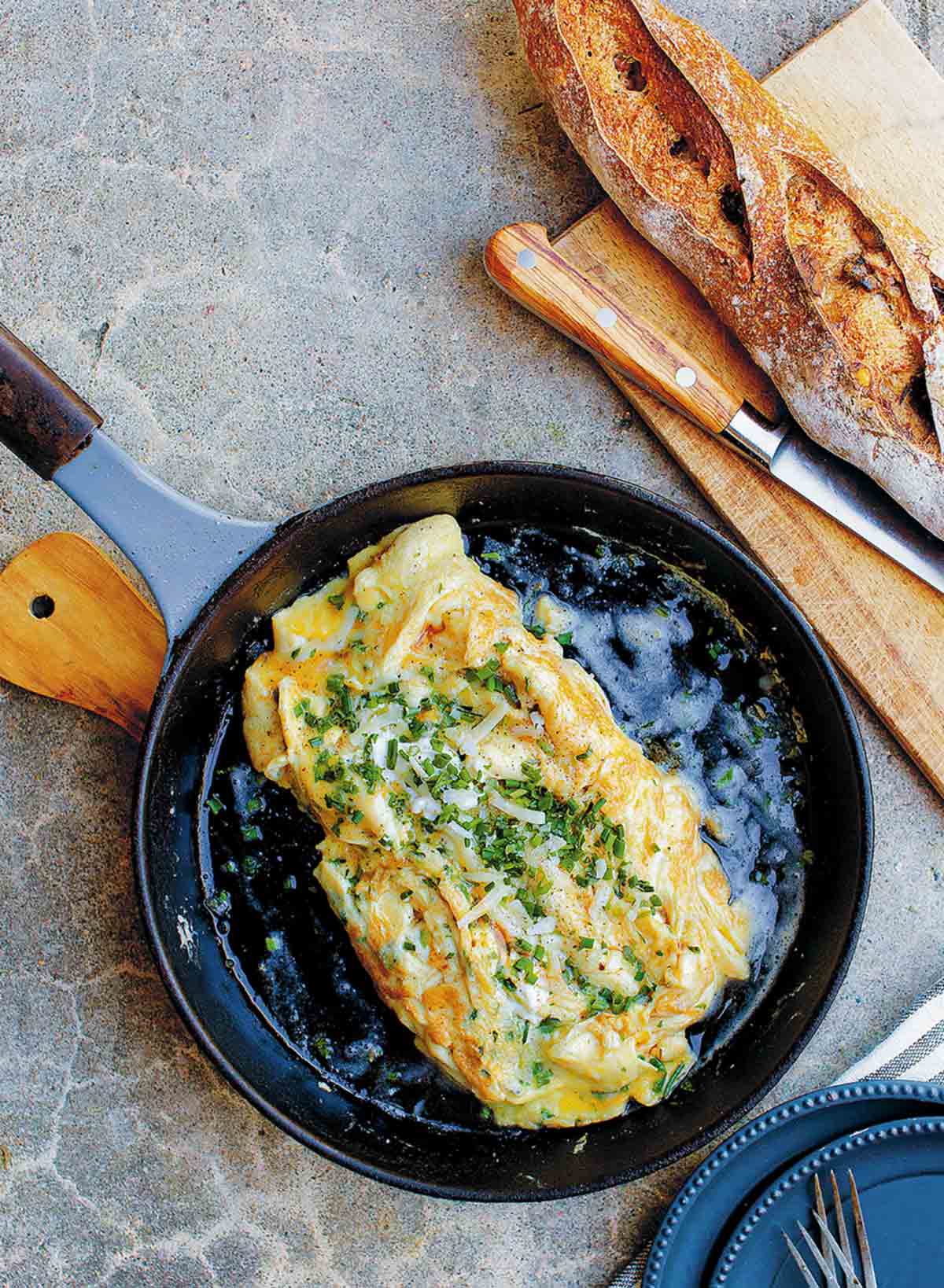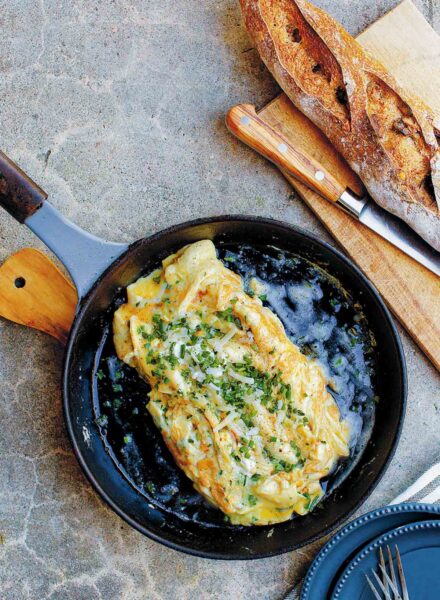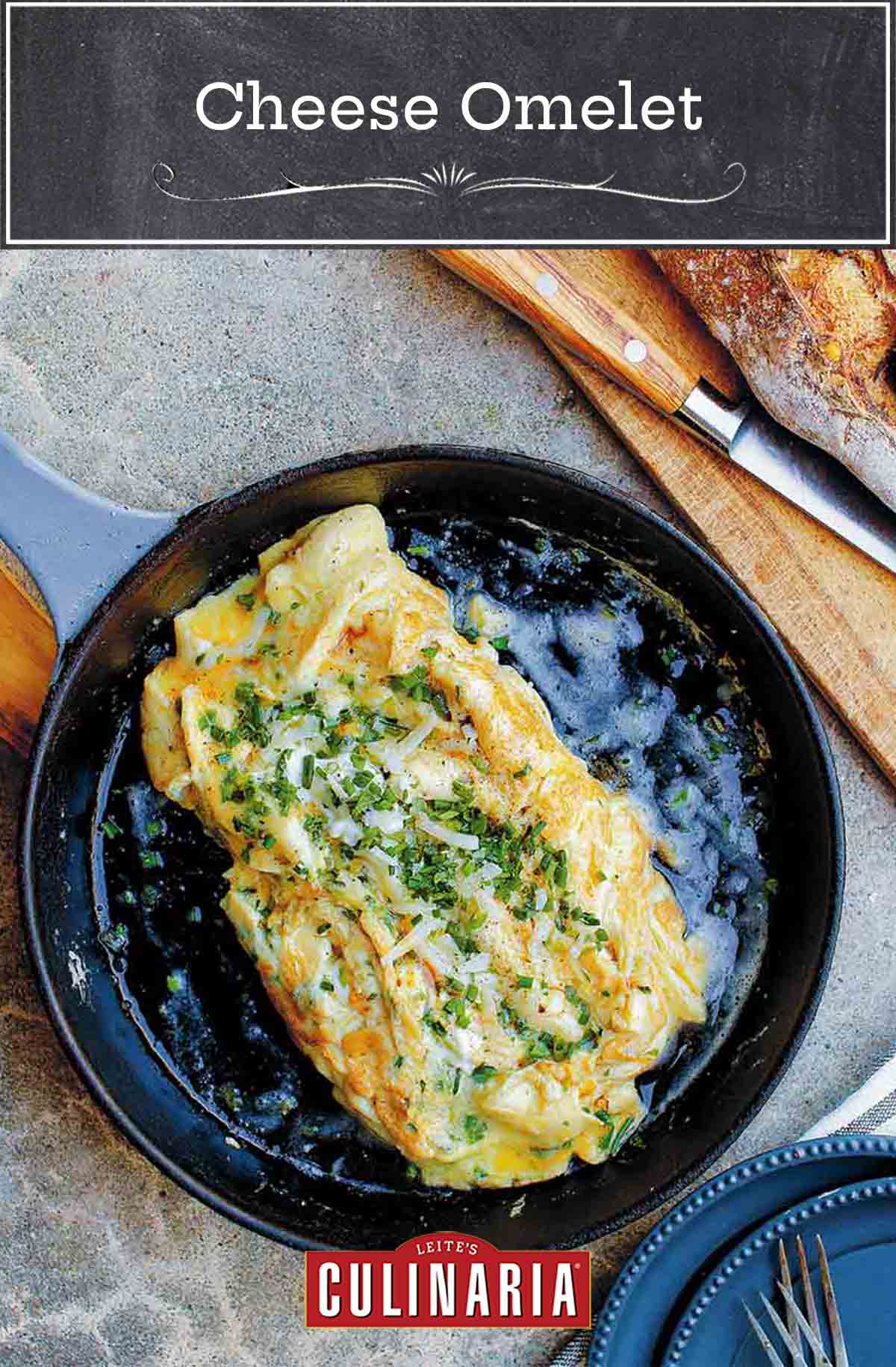
This is no ordinary cheese omelet recipe. It’s a magnificently indulgent cheese omelet for two that’s loaded with butter, cheese, and creme fraîche or sour cream and whatever herbs you please. And it isn’t something you make when you’re feeling abstemious. It’s what you make when you’re feeling like reveling in something simple yet still sophisticated that doesn’t take a lot of time or effort. Whatever time of day. Whatever your mood.
[Editor’s Note: This omelet is perhaps best described as a little egg along with an ample helping of cheese. If you prefer to flop those ratios, you would have sufficient filling from this recipe to make a second omelet. You would simply crack 4 more eggs, cook a second omelet after the first, and divvy the cheese and herbs between the two. Perfect to feed a couple more loved ones. Otherwise, by all means, make it as-is and be grateful to the gods of cheese gluttony.]–David Leite
Cheese Omelete FAQs
You can use almost any type of cheese in an omelet, depending on your preference and what you have stashed in the fridge. We love the pairing of Gruyère and tangy goat cheese here, but feel free to swap Boursin for the goat cheese, or use another semi-firm Swiss cheese.
If you’re getting creative with your cheese additions and swapping in whatever you’ve got on hand, keep in mind that you want to avoid using pre-shredded cheese as it doesn’t melt as well as hand-grated cheese.
This comforting cheese omelet is a hearty meal in itself, but feel free to round it out with some waffle iron hash browns, a side of homemade breakfast sausage, or a bowl of fresh fruit.

Cheese Omelet
Ingredients
- 4 large eggs
- 4 tablespoons cold water
- 1/4 cup finely chopped mixed fresh herbs, preferably flat-leaf parsley, thyme, tarragon, and chives (fines herbs)
- Sea salt and freshly ground black pepper
- 2 ounces soft, creamy cheese, such as goat cheese
- 3 tablespoons crème fraîche or sour cream
- 1 tablespoon (1/2 oz) unsalted butter
- 1 tablespoon extra-virgin olive oil
- 2 ounces finely grated Gruyère, plus more for sprinkling
- Bread or toast, for serving
Instructions
- Crack the eggs into a bowl and whisk them with the water until almost frothy. Whisk in half the chopped herbs and season with salt and pepper.
- In another small bowl, stir together the soft, creamy cheese with the sour cream or crème fraîche.
- Heat the butter and oil in a skillet over low heat.
- When the butter has completely melted, pour in the egg mixture and let it cook for a few moments without stirring. Using a spatula, slowly stir or scrape or simply loosen the bottom of the omelet to allow the uncooked egg to come in contact with the skillet. Pause a moment and repeat. Continue to cook the omelet in this fashion until the bottom and sides are gently set, the center is soft and creamy, and the underneath is just beginning to take on a little color.
☞ TESTER TIP: It may be necessary to increase the heat to medium-low but be mindful not to overcook the omelet or the egg will turn tough.
- Spread the grated cheese over the entire surface of the omelet and dollop the sour cream mixture along its center.
- Using a spatula, immediately fold the 2 sides of the omelet in over the cheese toward the middle and shimmy the omelet onto a plate or divvy it among 2 plates. Scatter the rest of the herbs over the omelet and, if desired, sprinkle with additional grated cheese. Serve with bread or toast.
Explore More with AI
Nutrition
Nutrition information is automatically calculated, so should only be used as an approximation.
Recipe Testers’ Reviews
Let me say that I’m not the best at making fancy schmancy omelets. Plain and simple is what I do best. And this omelet ticked all the boxes for me.
To begin, I chopped my herbs and mixed the cheeses with the creme fraîche so everything was ready to go. I used basil, tarragon, and parsley. In one omelet I used a caramelized onions, Cheddar, and about 2 tablespoons (1 ounce or 26 grams) of an herb and garlic yogurt cheese mixed with 1 tablespoon creme fraîche.
The end result was a lovely, creamy, and light cheese omelet. The creme fraîche mixture oozed out a lot when eating the omelet, but that wasn’t totally a bad thing as we had fresh bread to sop it up with.
In the second omelet, I used about 1 tablespoon (1/2 ounce or 15 grams) lemon goat cheese mixed with the creme fraîche and a light Gruyère shredded into the middle. Again, a lovely, citrus-scented, creamy, light omelet and just enough oozing of the filling.
These cheese omelets are easy enough for me to make without making a big mess in the pan and I discovered I do best when nudging the omelet from pan to plate.
I want to make this again with a Boursin cheese as I didn’t have any in the house.
P.S. My son brought home a Boursin cheese from work for me. I’m off to break a few eggs.
I love a good, basic omelet that’s cooked well. This recipe has some of my favorite ingredients in an omelet–Gruyere cheese and herbs. I grow my own herbs so I used a combination of chives, parsley, and a little thyme.
First, I whisked the eggs and water together. I chopped the herbs and added about 2 tablespoons to the egg mixture with a nice pinch of salt and freshly grated pepper. Before I heated my skillet, I mixed about 2 ounces Boursin cheese (5 ounces total weight) with about 2 healthy tablespoons sour cream. These proportions lended to a nice consistency and it was ready to add to the omelet when the time came.
The eggs were cooked nicely and the cheeses worked well together. I probably would not use so much of the Boursin if I made the omelet again, as it was tasty but richer than I expected. I served the omelet with some buttered wheat toast which was a nice side.
Loved the ease of this classic cheese omelet recipe—it’s the way a proper omelet should be made, in my opinion.
I made a few changes based on the fact that I am traveling and working in someone else’s (unfamiliar) kitchen. I used 1/4 cup finely chopped arugula and basil based on what I had on hand, 1 tablespoon (1/2 ounce) unsalted butter, and 1 tablespoon extra-virgin olive oil (I did not need all this oil for cooking as I used a super nonstick pan).
In place of Gruyere I used sharp Cheddar and I bought what I thought was creamy goat cheese but it was more like a goat Camembert. In place of sour cream I used heavy cream with a touch of lemon juice.
I did all my mise en place before I started cooking. I whisked the cream with my eggs, water, herbs, salt, and pepper because I couldn’t “mash” the cream with the kind of goat cheese I’d bought. At around 5 minutes cook time, I sprinkled the cheeses (I grated both) onto the middle of the omelette and continued to cook for about 3 more minutes. The eggs were “just” set. (I was working with a gas cooktop, which I am not used to, and perhaps had the heat higher than I would have on my regular cooktop as it seemed to cook quite fast.)
This cheese omelet is one you’ll commit to memory and be pleased to serve as dinner to guests with a lovely glass of wine or to indulge in a delicately rich breakfast for two on a weekend. Although this never pretends to be a diet omelet, I was a bit daunted by the amount of cheese called for in the recipe. I opted to use a reasonable quantity (about 2 ounces) of really special chèvre with black truffle from Laura Chenel in place of the Boursin (the goat cheese has half the fat), 50 grams of a good Gruyère, finely grated, and fresh herbs, very finely chopped.
If you don’t have the classic fines herbs (parsley, chives, chervil, and tarragon), use the best selection that you do have. I tried this recipe with parsley and thyme, mint and thyme, and when we realized the garden thyme had been devoured by a fiendish rabbit, I even tried a small amount of dry herbs (although this should be your last resort; you would add these directly to the egg mixture, as they’re not so nice for garnishing).
Use a pan you’re comfortable with that won’t stick—for some people, that’s a well-seasoned heavy cast-iron or carbon-steel skillet, and for others, it’s a nonstick pan. I used a heavy-bottomed stainless skillet. One thing I wrestled with was the size of the skillet. My first try was with an 11-inch skillet, which I felt was a bit too large, letting the fat and egg spread out a bit too thin. The 9-inch skillet was a better fit for 4 eggs, and if you’re making this for one person, an even smaller 6- to 7-inch pan works nicely. Do not overcook the omelet.
I found it was helpful to use a thin silicone spatula both to stir ever so slightly at the very beginning, then to loosen the edges as the egg began to firm up. After you add the grated Gruyère, immediately dollop the creamy mixture on top and use a spatula (or two) to fold the omelet over and divide it between 2 plates to serve.
I liked serving this with simple greens dressed with a citronette to complement the cheese. It is a grown-up omelette with a beautiful presentation that only requires a small amount of effort.
My favorite foods! I was really excited to find a recipe that incorporated some of my beloved garden herbs.
I chose thyme, parsley, and chives. I also used fresh local goat cheese. Instead of crème fraîche or sour cream, I used thick, cultured Greek yogurt, which I premixed with 1 ounce goat cheese. I wanted to use a little more, but the ratio of cheese to egg was looking pretty high once I grated the Gruyère.
I didn’t stir the omelet much as I wanted it to be pretty, so instead I shook it as well as made some slits in the middle bottom with my rubber spatula and the middle was still able to cook. Before it was entirely set, I first added the grated Gruyère, then a dollop of soft cheese mixture, then the herbs, and then I folded the omelet over the center. Next time, I’ll smear the mixture down the center evenly, as it kind of pooled in the center and ran out when I cut it in half.
And as someone who thinks cheese should be its own food group, I must admit I thought it was a tad cheesy—1 1/2 ounces Gruyère and 2 ounces each of soft cheese and cream-type product would be perfect for my taste. All in all, a lovely weekend omelet to enjoy!













